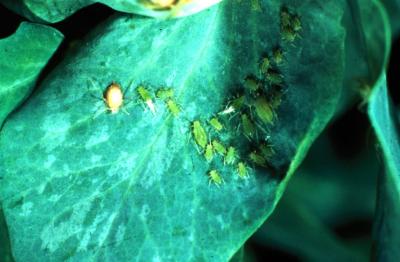
Vegetable
Aphids are small, pear-shaped, soft-bodied insects up to 1/8 inch long, usually with two tailpipelike posterior projections called cornicles. They are commonly green but can be any color. The nymphs are similar in shape but are smaller.
Aphids feed by sucking the juices from leaves and stems of spinach, cabbage, broccoli, brussels sprouts, tomato, pea, and other plants. Heavy numbers can cause leaf and stem distortion. In spinach, broccoli, and brussels sprouts, aphids commonly remain on the produce and become a contaminant for both fresh-market and processing crops. Much of what is sucked out of the plant is excreted as a concentrated sap or light syrup substance called honeydew that makes leaves sticky and may support sooty mold growth. High populations of corn leaf aphid produce enough honeydew to coat tassels and silks of sweet corn and reduce pollination and ear fill.
Natural enemies such as lady beetles, lacewings, and parasitic wasps provide control, particularly in crops that have not been treated with insecticides. Despite biological control, harvested spinach, broccoli, and brussels sprouts may contain too many aphids at harvest. Chemical control may be needed to ensure a high level of control in crop seedbeds. Aphid control is recommended for cabbage whenever aphid colonies are detected. With broccoli and cauliflower, control often can be delayed until just before heading when a "cleanup" is necessary to prevent contamination at harvest. Control infestations on greens if aphid densities exceed four to ten per plant. Treat aphids on pepper where colonies are building.
Insecticides are not effective for preventing or controlling aphidborne viral diseases in peppers. Treat eggplant and tomatoes if 25 to 50 percent of plants are infested by wingless aphids; count only wingless aphids because their presence indicates colonies have started. Control aphids on potatoes at rates of 30 green peach aphids per 100 leaves or 50 potato aphids per 100 leaves. Asparagus aphids are rarely a serious pest in Illinois, so treatment is usually not justified.